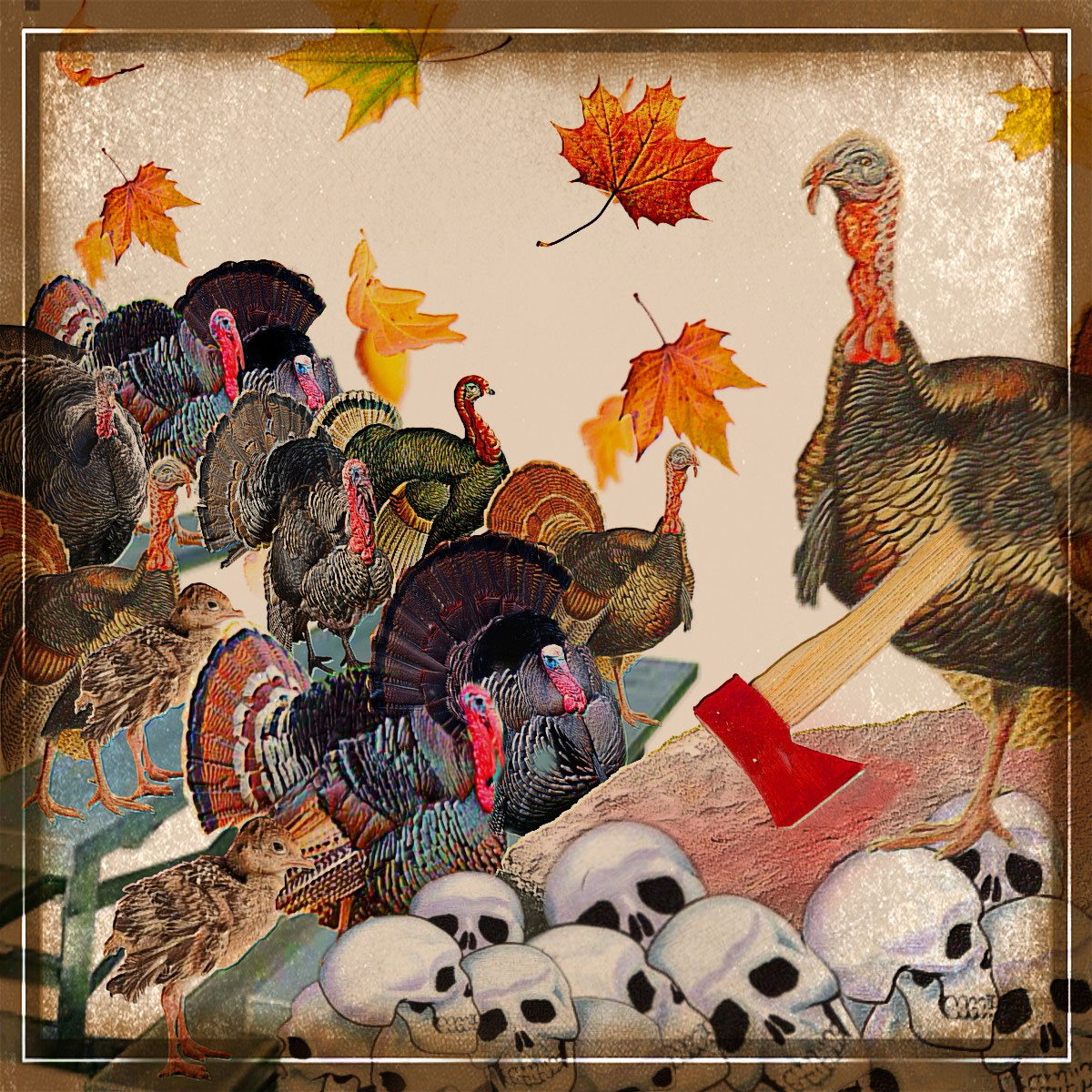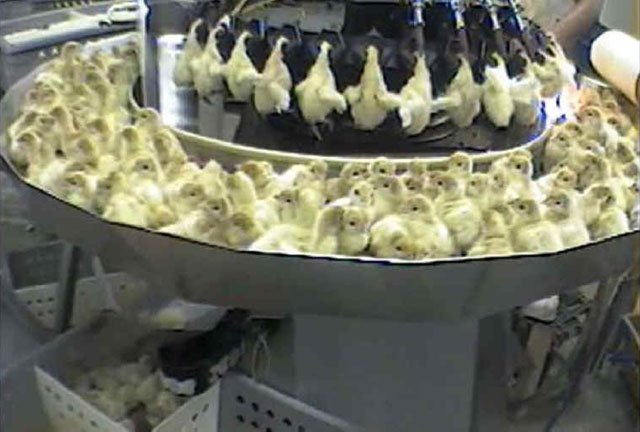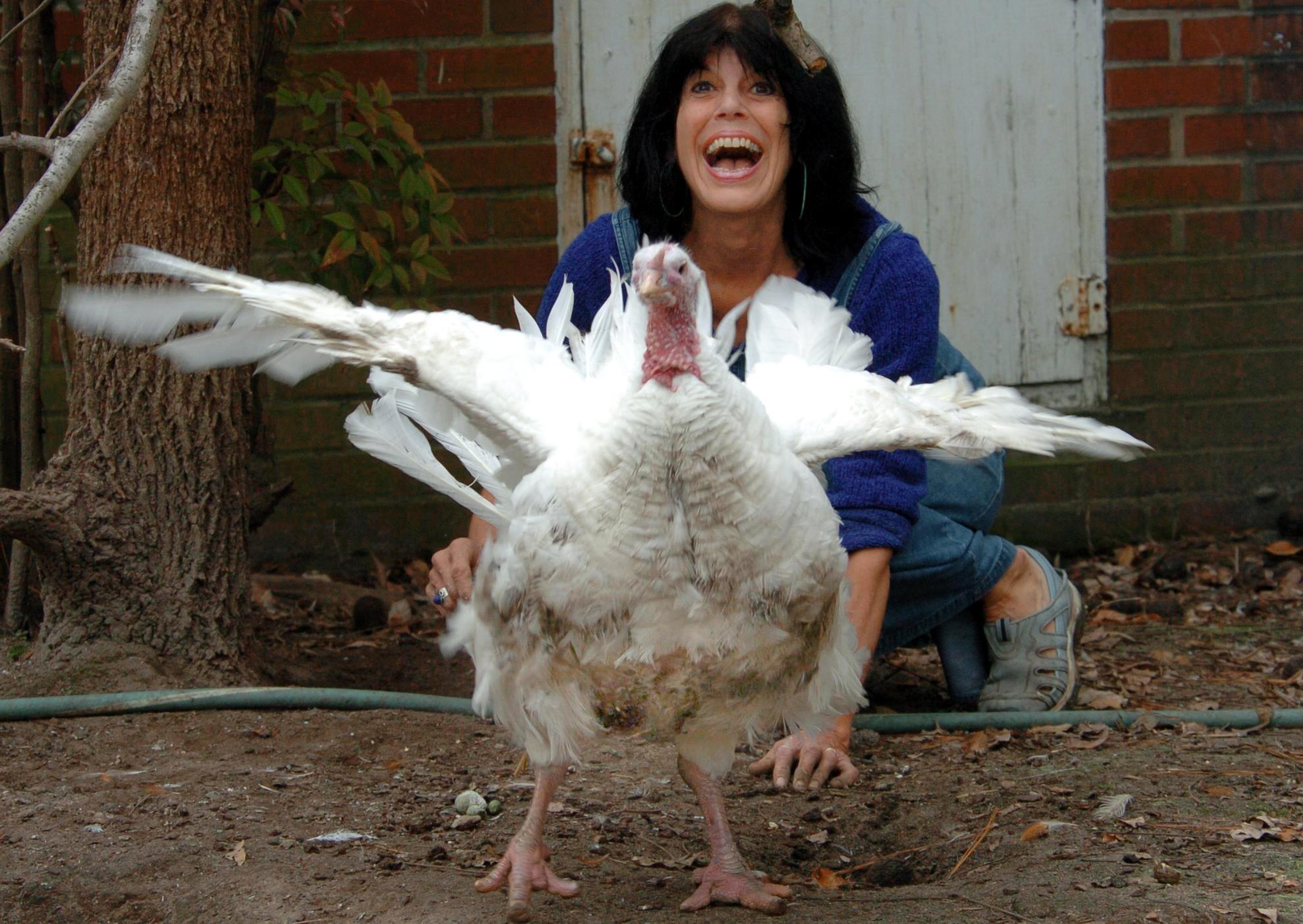
The Great Escape! (Beth Clifton collage)
The “Thanksgiving” Turkey:
Object of Sentimentality, Sarcasm, and Sacrifice
The “Thanksgiving” Turkey: Object of Sentimentality, Sarcasm, & Sacrifice was first published Nov 23, 2019 on the Animals 24-7 website. It was republished this year on the Animals 24-7 site November 23, 2022 with additional commentary.
In case anyone has not seen the PETA investigative report on a “humane” turkey farm in Pennsylvania, please read this article. Please understand that turkeys and other farmed animals will NEVER be treated humanely and that the companies that own them will ALWAYS lie. Such businesses bring out the worst in human nature, as this investigation, like countless other investigations of animal farms and slaughterhouses, shows.
The “Thanksgiving” Turkey:
Object of Sentimentality, Sarcasm, and Sacrifice
By Karen Davis, PhD, President, United Poultry Concerns

(Beth Clifton collage)
Each year a litany of sarcasm accompanies the sentimentality of Thanksgiving.
“Nothing so unites us as gathering with one mind to murder
someone we hate, unless it is coming together to share in a
meal.”
– Margaret Visser, The Rituals of Dinner, p. 33.
The Turkey and the Eagle in American Myth
The turkey is not America’s official national bird; the bald eagle of North America was adopted by the U.S. Congress in 1782. However, the turkey has become an American symbol, rivaling the eagle in actual, if not formal, significance. The turkey is ceremonially linked to Thanksgiving, the oldest holiday in the United States. Yet, unlike the eagle, the turkey is not a symbol of power and prestige.
Nor, despite frequent claims, is there any evidence that Benjamin Franklin (1706-1790) seriously promoted the turkey as the national bird – more “respectable” than the bald eagle, except as a passing jest in a letter to his married daughter, Sarah Bache, on January 26, 1784, two years after Congress had already adopted the bald eagle (Novak).
While the wild turkey has a long history of involvement with Native American, Colonial American, and European cultures, today the bird is invoked primarily in order to disparage commercially raised factory-farm turkeys. Little has changed since the consumer newsletter Moneysworth snarked on November 26, 1973:
“When Audubon painted it, it was a sleek, beautiful, though odd-headed bird, capable of flying 65 miles per hour. . . . Today, the turkey is an obese, immobile thing, hardly able to stand, much less fly. As for respectability, the big bird is so stupid that it must be taught to eat.”1

Baby turkeys on a laser debeaking carousel at the hatchery.
Photo by Compassion Over Killing.
Each year, this litany of sarcasm accompanies the sentimentality around Thanksgiving. Each year, the media ridicule the Thanksgiving Day bird. If yesterday it was certain ethnic populations and foreigners we insulted – a bigotry resurgent in the 21st century – today we can count on the likelihood that, as usual at Thanksgiving, turkeys will be exposed to humiliation and insult.
Strange Mixture of Honor and Hatred
Thanksgiving has other functions, but one thing it does is to formalize a desire to kill someone we hate and make a meal out of that someone. In this role, the turkey dinner is not far distant from a cannibal feast, in what Eli Sagan called that “strange mixture of honor and hatred” in which not a few cultures in history have disposed of their enemies and relatives in ceremonial fashion.
Many people to whom I mention this “hatred of the turkey” idea say they never noticed it before, or if they did, they gave it no thought. Such obliviousness illustrates, in part, the idea that the “most successful examples of manipulation are those which exploit practices which clearly meet a felt – not necessarily a clearly understood – need among particular bodies of people,” according to Eric Hobsbawn and Terence Ranger on page 307 of The Invention of Tradition.
In the case of Thanksgiving, the need is not so much to eat a turkey, a patriotic obligation that many people reject, but to rationalize an activity that, despite every effort to make the turkey seem more like a turnip, has purposely failed to obliterate the bird into just meat. To do so would diminish the bird’s dual role in creating the full Thanksgiving experience.
“Performance of Killing” Must Be “Seen” to Be Real
To affect people properly, a sacrificial animal must not only be eaten by them; the animal’s death must be “witnessed by them, and not suffered out of sight as we now arrange matters.” But since this is how we now arrange matters – the modern Do It Yourself slaughter fetish notwithstanding – attention must somehow be “deliberately drawn, by means of ritual and ceremony” to the reality of the animal’s life and the “performance of killing,” observes Margaret Visser in her survey of eating customs from prehistory to the present, The Rituals of Dinner (32).
This is why, to be ritually meaningful, the turkey continues to be culturally constructed as a sacred player in our drama about ourselves as a nation, at the same time that we insist that the bird is a nobody, an anonymous “production animal.” For Visser, what is meant by “sacrifice” is literally the “making sacred” of an animal consumed for dinner. No wonder that mentioning cannibalism in connection with eating turkeys or any other animals provokes a storm of protest, since as she says, cannibalism to the Western mind is “massively taboo,” more damnable than incest (5).
Cannibalism
However, cannibalism, transposed to the consumption of a nonhuman animal, is a critical, if largely unconscious, component of America’s Thanksgiving ritual.2
America knows at some level that it has to manage its portion of humanity’s primeval desire to have “somebody” suffer and die ritualistically for the benefit of the community or the nation at a time when the consumption of nonhuman animals has become morally problematic in the West as well as industrialized to the point where the eaters can barely imagine the animals involved in their meal. It is ironic, Visser says on page 32, that “people who calmly organize daily hecatombs of beasts, and who are among the most death-dealing carnivores the world has ever seen,” are shocked by the slaughtering of animals in other cultures.

Photo of a mother turkey and her growing children by Jeff Borchers, The Kerulos Center
Notes
1. In nature, baby turkeys are taught how to forage for food by their mothers. Deprived of the maternal care and teachings they evolved to experience in the company of their mothers for their first 5 months of life, newborn turkeys suffer unimaginably on factory farms. Not only are they bereft of their mothers; they are declawed and their beaks are painfully mutilated with blades or lasers as soon as they hatch in the mechanical incubators from which they proceed to a life of merciless, bewildering misery for three to five months, until those who survive the ordeal are murdered in a slaughterhouse. A turkey researcher summed up the newborn turkeys’ experience in the first hours of hatching: “Essentially, they have been through major surgery. They have been traumatized” (Donaldson). These “major surgeries” are inflicted on the turkeys without anesthesia or post-surgical pain killers.
2. Margaret Visser writes on page 33 of The Rituals of Dinner that myths about sacrifice “often tell us that the animal killed and eaten takes the place of the original sacrificial offering, a human being. . . . Animals, according to this apprehension, are surrogates, substitutes for members of our own species whom we once joined in killing.” Visser notes also the traditional “eliciting of signs that the animal does not mind dying to feed us.” On the one hand we relish the exertion of absolute power over an animal who does not want to die. On the other hand we like the idea that an animal desires to suffer and die for the sake of the “superior” species.
References
Karen Davis. More Than a Meal: The Turkey in History, Myth, Ritual, and Reality. New York: Lantern Books, 2001.
William E. Donaldson, et al. “Early Poult Mortality: The Role of Stressors and Diet.” Turkey World (January-February), 27-29. See p. 138 of Karen Davis’s More Than a Meal.
Eric Hobsbawn, and Terrence Ranger, eds. The Invention of Tradition. Cambridge: Cambridge University Press, 1983.
“The Light and Dark Sides of Thanksgiving Turkey.” Moneysworth: The Consumer Newsletter 4.4 (November 26, 1973), 1-2.
Matt Novak. “Did Ben Franklin Want the Turkey to Be Our National Symbol?” GIZMODO, November 20, 2014.
Eli Sagan. Cannibalism: Human Aggression and Cultural Form. New York: The Psychohistory Press, 1974.
Margaret Visser. The Rituals of Dinner: The Origins, Evolution, Eccentricities, and Meaning of Table Manners. New York: Penguin Books, 1992.
KAREN DAVIS, PhD is the President and Founder of United Poultry Concerns, a nonprofit organization that promotes the compassionate and respectful treatment of domestic fowl including a sanctuary for chickens in Virginia. Inducted into the National Animal Rights Hall of Fame for Outstanding Contributions to Animal Liberation, Karen is the author of numerous books, essays, articles and campaigns. Her latest book is For the Birds: From Exploitation to Liberation: Essays on Chickens, Turkeys, and Other Domesticated Fowl (Lantern Books, 2019). To order Karen’s books, visit UPC Books.

Karen and Florence
Photo by John H. Sheally, The Virginian-Pilot
Don't just switch from beef to chicken. Go Vegan.
www.UPC-online.org


